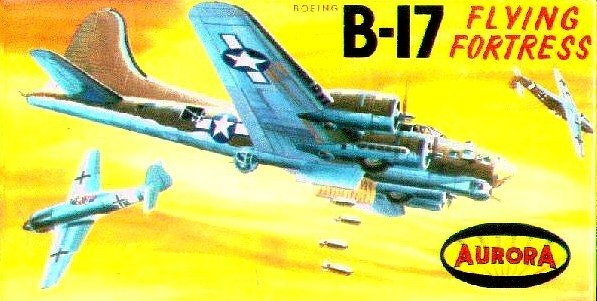
|
KIT: |
Aurora B-17G |
|
KIT # |
491-49 |
|
PRICE: |
$0.49 (1962) |
|
DECALS: |
One aircraft |
|
REVIEW : |
Roger Jackson |
|
NOTES: |
Famous Fighters series` |

|
HISTORY |
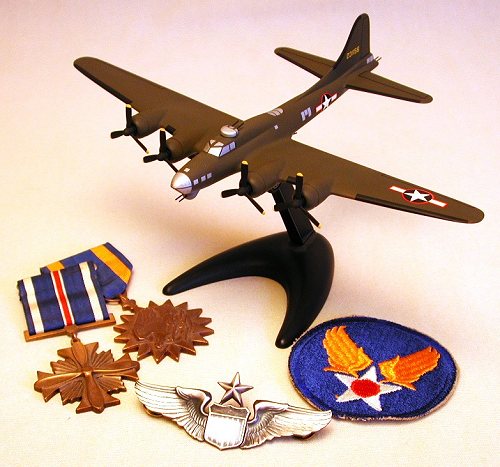
The Boeing B-17G was the ultimate wartime variant of the company’s original B-299 design. Dating back to the mid 1930s, the robustly constructed prototype would eventually mature into what would soon become the 8th Air Force personified. The superb lines and graceful proportions belied the aircraft’s strategic purpose as a heavy bombardment platform, while solid engineering enabled the Flying Fortress to withstand massive battle damage that surely would have felled lesser planes.
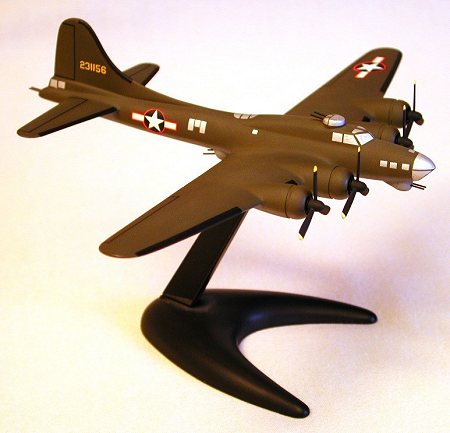 B-17Gs superceded the ‘F’ models on the production line in the spring of
1943. Various enhancements over the previous model included additional armor,
added ammunition storage, a revised de-icing system, improved cabin heaters, and
in later blocks within the marque, staggered waist gun positions and the
Cheyenne tail turret. Contrary to popular belief, the ‘chin’ turret (originally
developed for the aborted YB-40 program) was not an exclusive ‘G’ model
improvement, this feature having been fitted to the last 70 B-17Fs to roll from
the Lockheed/Vega production facility.
B-17Gs superceded the ‘F’ models on the production line in the spring of
1943. Various enhancements over the previous model included additional armor,
added ammunition storage, a revised de-icing system, improved cabin heaters, and
in later blocks within the marque, staggered waist gun positions and the
Cheyenne tail turret. Contrary to popular belief, the ‘chin’ turret (originally
developed for the aborted YB-40 program) was not an exclusive ‘G’ model
improvement, this feature having been fitted to the last 70 B-17Fs to roll from
the Lockheed/Vega production facility.
All of this added equipment took a toll on the ‘G’ model’s performance, as the Wright Cyclone powerplants were taxed to the limit. Though the service ceiling and cruising speed were only marginally reduced, the B-17G could seldom approach the maximum figures of its earlier brethren. Nevertheless, most squadrons mixed ‘F’s and ‘G’s without any deleterious effects to either unit cohesion or combat effectiveness. B-17Gs were among the first aircraft to be fitted with BTO (bombing through overcast) equipment, with the radome replacing the ball turret.
In late 1943 camouflage paint was ordered deleted by the Army Air Force, both to speed production and to save weight. In addition, the perceived tactical advantage was deemed dubious, while the 250 pound weight savings could easily translate to an extra 1000 rounds of .50 caliber ammunition or forty gallons of fuel. Production ceased in the summer of 1945 following V-E day, as Boeing plants switched over to B-29 production. Total production amounted to 12,731 planes, 8680 of which were B-17Gs.
Following the war, many low-time Flying Fortresses found new homes as test aircraft, trainers, and squadron hacks while its stable mate, the B-24, was unceremoniously dumped in prodigious numbers in Litchfield Park, Avondale, and Kingman, Arizona. Numerous B-17s were drafted into civilian service as cargo ships, borate bombers, and executive transports, while several survivors would eventually be restored as Warbirds, thrilling airshow crowds and bringing a tear to the eye of many a veteran from "the last great war".
|
THE KIT |
Aurora’s B-17G kit consists of 24 olive green parts with clear pieces for the nose, top turret, radio compartment hatch, and ball turret. A two-piece display stand is furnished along with decals offering a generic nondescript scheme. The fold-out construction guide specifies both assembly sequence and minimal painting cues along with a brief history of the aircraft. The scale is not listed but measurements indicate approximately 1/140.
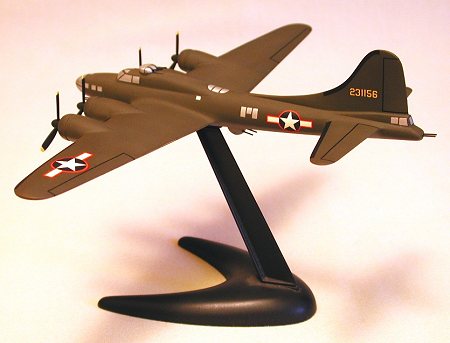 The mid ‘50s vintage mandates the obligatory pilot’s head-sized rivets over
the entire exterior surface with raised ribs denoting the doped fabric areas of
the ailerons, stabilizers, and rudder. No transparencies are provided for the
navigator’s compartment, cockpit, or waist and tail gun positions, though the
apertures are molded open to afford some contrasting delineation.
The mid ‘50s vintage mandates the obligatory pilot’s head-sized rivets over
the entire exterior surface with raised ribs denoting the doped fabric areas of
the ailerons, stabilizers, and rudder. No transparencies are provided for the
navigator’s compartment, cockpit, or waist and tail gun positions, though the
apertures are molded open to afford some contrasting delineation.
Gun barrels are molded integral with the chin turret and the extreme ends of the fuselage halves, providing the kit’s sole ‘armament’. The featureless wheels have the struts molded to them while the propellers have grossly thick overscale blades. There are no depictions of the prominent turbo-superchargers on the engine nacelles nor engine fronts on the cowlings.
The overall shape and proportions look good in both profile and planform with the only gaff being the nose glass—a little too pointed, more akin to the ‘F’ model (offering the possibility of conversion). Modelers will have no excuse for mis-locating decals as there are embossed guides provided for all items molded right on the model.
Throughout this kit’s entire production run, spanning some 14 years, the packaging never changed, though a trio of these models were also offered as a boxed set with a tie-in to "Twelve O’clock High", a television show derived from the movie and popular in the early 1960s. The display stand for this issue was a 3-in-1 unit with the base simulating a prototypical Axis city.
|
CONSTRUCTION |
This project was a ‘broom and dustpan’ job—I had inherited the model twenty years ago as a build-up from a neighbor at Ft. Meade who had constructed it as a glue-obsessed adolescent with ADD (remember, this was in the pre-Ritalin days of the early ‘60s). As such, it was a basket case… Red Testor’s tube cement all over the place, missing and broken parts, tailplanes on backwards…geez!
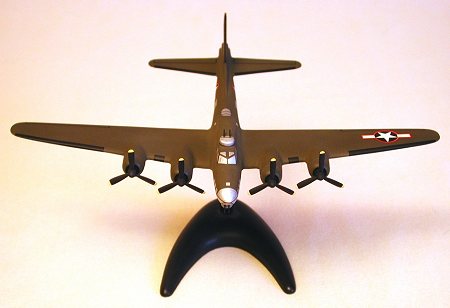 As such, a normal assembly narrative is neither applicable not appropriate.
Suffice to say, I disassembled as much as I could, fixed what was fixable,
cleaned up what was cleanable, reassembled it, then sanded the bejezus out of
it. As I had already decided that this model might pass as a ‘six-foot
desktop display piece’, I filled in all the missing windows with Evergreen sheet
and sanded them flush.
As such, a normal assembly narrative is neither applicable not appropriate.
Suffice to say, I disassembled as much as I could, fixed what was fixable,
cleaned up what was cleanable, reassembled it, then sanded the bejezus out of
it. As I had already decided that this model might pass as a ‘six-foot
desktop display piece’, I filled in all the missing windows with Evergreen sheet
and sanded them flush.
The missing guns were fashioned from brass wire while the broken propellers were replaced with units modified from the Monogram 1649 Super Constellation. The long-since AWOL landing gear was simulated in the retracted position courtesy of a pair of wheels from my spares box as I didn’t feel like excavating an entire back yard in Wilkes Barre, PA on an undoubtedly fruitless search.
Getting a surface suitable for paint proved to be a real adventure as the brittle Aurora styrene had further petrified itself in the intervening decades. After two packs of doctor-ordered Flex-Grit I arrived at some semblance of smooth and called for Pablo Picasso…
|
PAINT & DECALS |
A home-brewed OD and Modelmaster Neutral Gray were stand-ins for the official ANA 41/43 colors with the propellers, tires, and guns done in black. When the paint had dried I used silver decal, cut to shape, to simulate the windows. Likewise, black decal was used on the de-icer boots and to delineate the movable control surfaces.
National insignias from an old A.I.R. sheet and serial numbers from Microscale completed the markings. A surplus display stand left over from an Airfix Wellington project was drafted to support the diminutive Flying Fortress, reprieved at last from purgatory.
|
CONCLUSIONS |
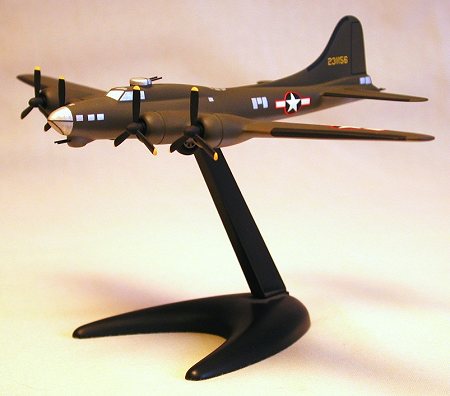 By contemporary standards this is a real pooch of a kit, but I love rescuing
lost puppies. While Crown and Minicraft offer excellent small-scale models of
the B-17, those kits lack the nostalgic charm that fired the imagination of
America’s youngsters in the ‘50s and ‘60s. Contrasts in the packaging are
doubtless a critical factor here. I mean, who could resist this model beckoning
from the shelf at the Rexall after seeing the boxtop? The marauding nazzies
ganging up on our gallant lads, defensive fire valiantly pouring from all
the guns, the skies ablaze in crimson and gold hues of honor and
victory, while Uncle Sam’s message pours forth from the open bomb bay…ah,
the wages of misspent youth.
By contemporary standards this is a real pooch of a kit, but I love rescuing
lost puppies. While Crown and Minicraft offer excellent small-scale models of
the B-17, those kits lack the nostalgic charm that fired the imagination of
America’s youngsters in the ‘50s and ‘60s. Contrasts in the packaging are
doubtless a critical factor here. I mean, who could resist this model beckoning
from the shelf at the Rexall after seeing the boxtop? The marauding nazzies
ganging up on our gallant lads, defensive fire valiantly pouring from all
the guns, the skies ablaze in crimson and gold hues of honor and
victory, while Uncle Sam’s message pours forth from the open bomb bay…ah,
the wages of misspent youth.
When Aurora tanked in the early ‘70s and closed its West Hempstead, New York factory for good, many of their molds were purchased by Monogram, to be retooled and re-issued as ‘new’ releases. Unfortunately, the little B-17 has never resurfaced. The molds may have been lost, damaged, or perhaps Monogram saw minimal potential for profit. This kit may be found on collectors’ tables but the hefty premium probably ensures that the few remaining models will never actually be built. However, a lucky modeler might yet stumble across one at a swap-meet or garage sale—who can say?
|
REFERENCES |
The Mighty Eighth – Roger Freeman; Scribners
B-17 In Action – Steve Birdsall; Squadron-Signal Publications
B-17 In Action – Larry Davis; Squadron-Signal Publications
B-17 Flying Fortress: Fighting Colors – Steve Birdsall; Squadron-Signal Publications
Bomber Command – Jeffrey Ethell; Motorbooks International
B-17 Fortress At War – Roger Freeman; Scribners
Review kit courtesy of MSgt Robert Gallagher, USA-CID, Retired
Boxtop art courtesy of MSgt Al Superczynski, USA-SC, Retired
Ó September 2001 by Roger M. Jackson
First Time North American Rights To Scott Van Aken and ‘Modeling Madness’
If you would like your product reviewed fairly and quickly by a site that averages thousands of visits a day, please contact me or see other details in the Note to Contributors.